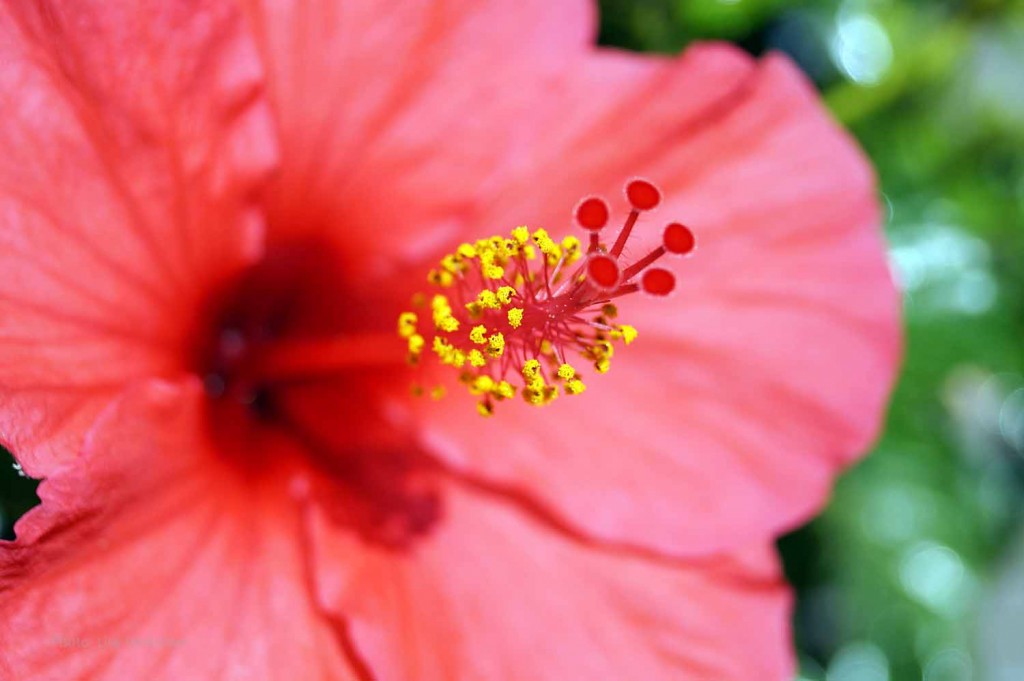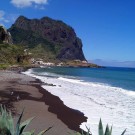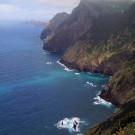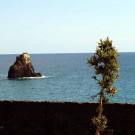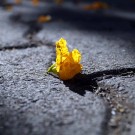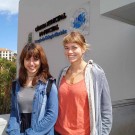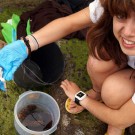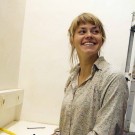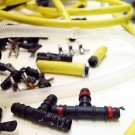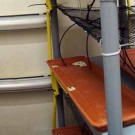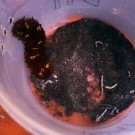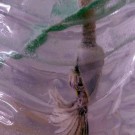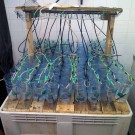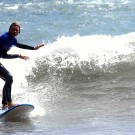They call Madeira the “Island of the Flowers“ and this is not an understatement. Every morning when we jump off the bus, there are these violet flowers smelling like honey, and, when we proceed down the street, we find the whole place covered with orange blossoms. On our way to work, we move along bushes shining pink & purple and we pass by trees with huge red trompet-like funnels until we arrive at our working place: The Estação de Biologia Marinha do Funchal.
The station is a white building that constitutes a widely visible landmark between land and sea. It stands directly in front of Lido, the tourism district of Funchal, where hotels with swimming pools, restaurants, souvenir shops and island trip agencies create a holiday atmosphere for the numerous tourists on the island. It faces an impressive rock that looks like a gigantic shark fin. Furthermore, from our lab window we can see Madeirans and tourists laying in the sun at a rocky beach, which they share with lizards that scurry over the heated stones. So, sometimes we think of jumping into the sea, while we are mixing microplastics with sediment or when we work on our experimental installations.
Both of us are first timers in running experiments in ecology. Two months have past since we began with preparing our set-up and we are glad to say that finally we have now started our main experiment in the first week of June. Of course later than initially planned…
We came to Madeira with all the discussions and preparations in mind that we had at GEOMAR in Kiel during March. However, to set-up an experiment requires concentrated work and endurance in many ways. First, we thought, ok let’s set it up and go, because a good part of last years’s experiment was very similar to ours. In 2013, the GAME team also worked with microplastics and they investigated the same study organisms. We therefore expected that it will be easy and fast to get the first experiment running. In the lab, we found lots of materials from the last year, such as containers, shelves, air and water tubes, etc. However, it required some weeks to modify everything in such a way that it was suitable for our purposes. We repaired water trays that were leaking, spend many hours connecting tubes, preparing tanks, placing airstones, collecting sand…
Fortunately, the marine station has two big storage tanks which help to provide our test containers with a constant water flow, so that we do not need to exchange the water manually every day. However, what turned out to be a problem was that we were not allowed to use the drainage system of the wet-lab to get the water back out of the building. This was because the pipes were old and leaking, so that water was dripping through the ceiling of the room below the lab. So, we needed to install a pipe-system ourselves that transports all the water to one confined drainage outlet.
As you see, during the first month, we spent most of our time with the technical aspects of the project.
It all has its pros and cons: First of all, we learned something important for our lifes’ as scientists, for instance, how much time and effort it takes to put thoughts into practise – and that it is a journey of trial and error. We repeated steps a hundred times and then realized that things do not work the way we planned them to work. For example, we drilled holes in every single experimental container to allow the water to overflow. Then we glued pieces of a fine plankton net over the holes to avoid the loss of the small-sized plastic material we are going to add to every tank during the experiments. However, when we were finished, we found out that it does not work – too little water goes through the fine net! So, in the end, we decided to put all hundred net pieces away again to allow the water to flow out freely. And then we realized that the plastic was not a problem at all, because it was not going out of the containers anyway.
We are also learning a lot about the biological background of the experiments we conduct. This year’s GAME project is about studying the effects of microplastics on deposit and benthic filter feeders. For the first, we use the sea cucumber Holothuria sanctori, while the goose barnacle Lepas anatifera is our filter feeder.
Sea cucumbers are echinoderms that live on the sea floor and swallow the sediment to take out the organic particles contained in it. Our test species, Holothuria sanctori, can vary in colour, from dark to light brown with white spots. When disturbed, they can excrete a sticky substance to defend themselves (called Cuvieran tubules) and if they are under severe stress they may even explode (i.e. they release their guts which are then regenerated).
Although they look like mussels, goose neck barnacles belong to the crustaceans. They live in huge colonies attached to rocks in the intertidal zones or floating objects in the open sea, such as buoys or fishing nets. Unlike most other types of barnacles, the intertidal barnacle species depend on waterflow rather than using the cirri for feeding. Cirri are body parts, looking like eyelashes, which the barnacle uses for feeding and also for respiration.
Knowing all this, it becomes obvious that it is a difficult task to provide our test organisms an environment that is similar to their natural marine habitat and that is not exerting any stress on them. For instance, to ensure a good water quality, we have to check the water flow-though and the oxygen supply through diffusor stones daily.
We gained more experience and more knowledge about the behaviour and ecology of our test organisms during the pilot studies. These pilot trials also served to identify suitable response variables, such as faeces production and respiration rates, by investigating only a small group of individuals. While doing this, we also recognized that sea cucumbers are really strange marine animals. Their body-shape changes constantly and they usually contain a lot of water. This makes it very difficult to measure their size and weight accurately. Furthermore, it was an early morning adventure to collect them at a beach close to Madeira’s capitol Funchal. We put our feet and hands in the water for more than two hours and turned hundreds of stones to find sea cucumber underneath them. Once spotted, we took them gently with our hands, but still most of them showed us how they defend themselves: They their gluey excrete onto us – the Cuvierian tubules.
Shivering from the long cold bath and full of “spider webs” on our legs, arms and in our hair, we went back to the lab. Now, 90 of these animals live in their new temporary home in the marine station – carefully guarded and looked after by us every day. For the experiments, we provided them sediment and added different amounts of contaminated microplastics to see if this has an effect on their performance.
After having started the experiments with the deposit feeders, it is now time to get more experimental units ready for hosting our second test organism, the gooseneck barnacle Lepas anatifera. These animals will be kept in 1.5 liter water bottles, which we cut open at the bottom and turn upside down. In this fashion, they will be placed in wooden racks, which we constructed especially for this purpose.
However, at the moment very detailed questions keep us busy: How to attach the barnacles inside the bottles? How to establish a water flow-through with this set-up that will ensure that the water quality will not decline during the experiments? And where to find enough of the barnacles for our study? Questions appear as we go along but, luckily, answers appear too, often due to the great support from the Funchal lab team: Joao, Patricio, Filipa and Dennis, all former GAME participants who help us out when we get stuck with theoretical and practical issues.
The weekly Skype conferences with our partners all around the world provide us further support. It is good to keep in touch with them: It makes us feel more comfortable about what we are doing and each time we realize that we are not alone in this global project.
Being a member of a two-person team on Madeira is also a big advantage, because you share your thoughts and make decisions together. Of course you can also enjoy some moments like dancing in the lab while working or making jokes J.
Weeks have passed as if they were minutes. During the working days, we are diving into that “ocean” that is called a biological experiment and when the weekends appear as “islands” in the sea, we doze in the sun like the people in front of our lab window. Or we do like the many Madeira tourists and walk along one of the hundreds hiking trails or pick other typical things from the “tourism menu”: Madeira wine, road trips along the island, the theatre program or learning how to stand on a surf board.
By Lisa Hentschel and Laura Nogueira Mazaira
- The coast of the island is mostly rocky with only a few beaches.
- A large part of the coastline consists of cliffs.
- View from the lab: The sharkfin shaped rock in front of the Estação de Biologia Marinha do Funchal.
- Flowers on the way to work.
- Team Madeira (Laura and Lisa) in front of the Estação de Biologia Marinha
- Laura with a bucket of sea cucumbers showing the defence excrete.
- Lisa is cutting the tubes for the water supply system
- Preparing the set-up for the experiment with the sea cucumbers.
- Inside the lab.
- Sea cucumbers in their experimental containers with microplastics.
- The goose neck barnacle Lepas anatifera.
- Building the set-up for the experiments with the barnacles.
- Lisa taking surf lessons in Porto da Cruz in the North of Madeira.
Madeira has many different aspects for a visitor to discover and they are always accompanied by the omnipresence of the ocean. An ocean that we associate with indefinite horizons but we become more and more aware that it has its limitations. We have to react to the consequences of polluting the great waters and this will take time and efforts. But there are solutions even to this problem. That is something what we learned here in the lab: There is always a solution, even if we have to build and rebuild the set-up hundred times, as long as we stay flexible, patient, take decisions and learn from the difficulties that come along.
